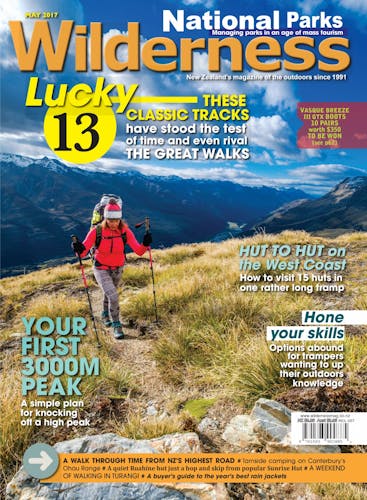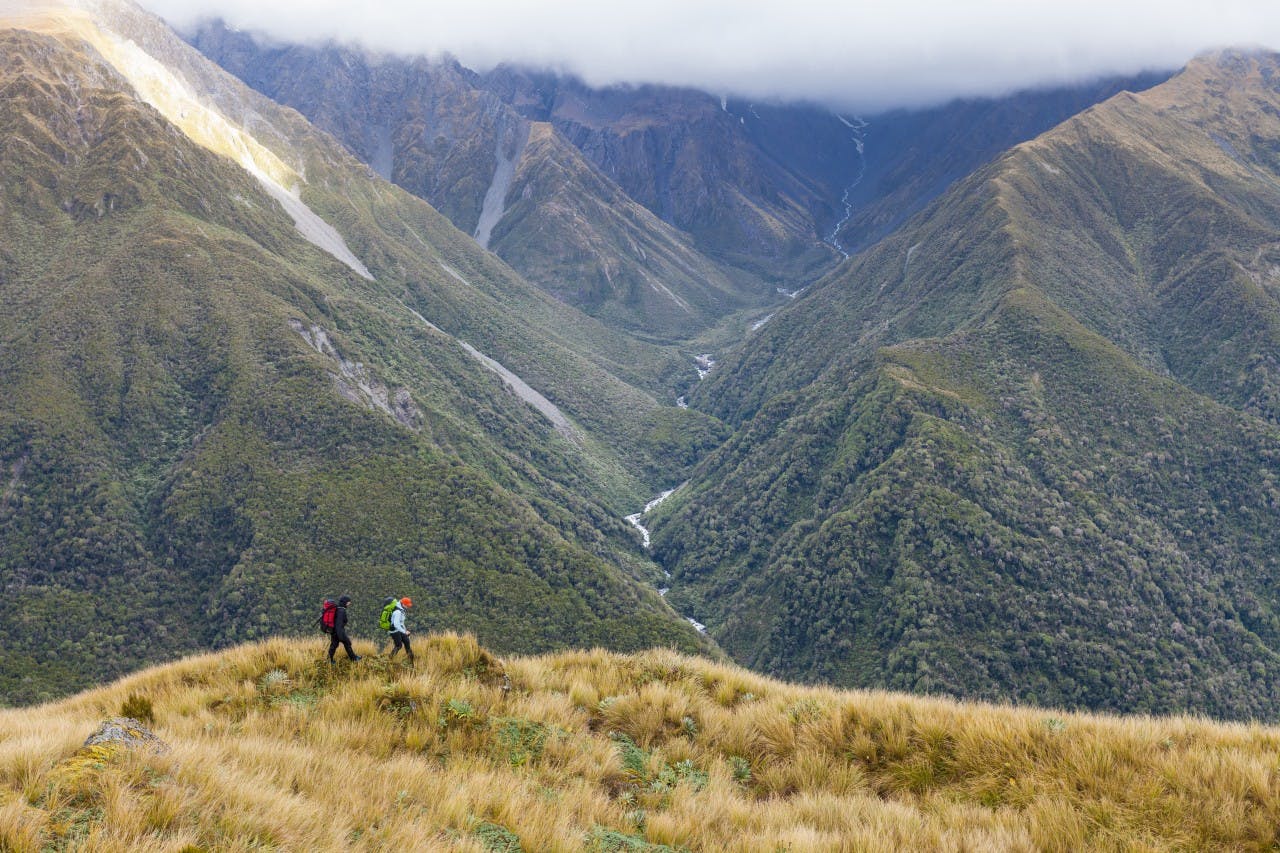- Distance
- 86.6km
- Total Ascent
- 6433m
- Time
- 7-9 days, but many options exist to shorten the trip
- Grade
- Difficult
- Accom.
- Numerous huts and bivouacs
- Access
- Milltown Road, inland from Hokitika
- Map
- BV19, BV18
- GPX File
- Arahura to Whitcombe.West Coast (gpx, yo 164 KB)
- Your device does not support GPX files. Please try a different device.
To mark Wilderness magazine’s 30th anniversary, current and past editors and contributors scoured the archives for the 30 best trips we’ve published over the decades. This story, original published in May 2017, was included. You can find all 30 of the greatest Wilderness trips in the October 2021 issue.
With challenging terrain and an extensive network of huts and tracks, the Hokitika backcountry is a tramper’s paradise. Mark Watson describes an eight-day journey from the Arahura to the Whitcombe
Paper, scissors, rock called it: Tom and Anna would pitch their tent, while Hana and I got the two-person bivvy, set cosily in the scrub on the bushline of Browning Range. We were two days from the road now; two days into a post-Easter trip that we’d nearly called off due to record storms that had flattened sections of forest up and down the ranges. Encouraged by a passable forecast that suggested at least a couple of clear days, we’d begun up the Arahura Valley, its river still flowing high and the forest dripping and steamy.
Our plan was to traverse from the Arahura to the Whitcombe Rivers over Styx Saddle, Lathrop Saddle, the Toaroha Range, Toaroha Saddle and Frew Saddle. An ‘extended mix’ of a well-trodden West Coast circuit. It so happened that we’d visit 15 huts along the way – making it an efficient hut bagging trip.
Travel had been fast along the old pack tracks of the Arahura. We dropped heavy packs and sheltered from the rain for lunch at Lower Arahura Hut and then overnighted at Mudflats Hut. Descending Styx Saddle the next day, Anna slipped on a root and sprained her ankle. We sat on the track for some time while she caught her breath. A stretchy bandage was applied while Anna figured which foot movements hurt and which didn’t. She got to her feet – walked a few steps with the help of a walking pole – and announced herself fit to continue. Well, at least as far as the next hut.
The rain returned while we ate lunch at Grassy Flat Hut and added to the uncertainty of Anna’s ability to continue; thoughts of camping on Lathrop Saddle were abandoned. We pushed on slowly up the steep creek and muddy track into the mist to Browning Range Bivouac and all four of us crammed inside to wait out the rain. We cooked and ate and warmed ourselves, thankful for the most humble of shelters. Near sunset, the rain stopped and the cloud dissipated, revealing the bare tops of the Newton Range opposite us and hope of a clear tomorrow.
Top Kokatahi Hut # Day Four
We left Crawford Junction Hut early. Rivers were in high flow, making travel along their edges slower than usual. We’d had a long day from Browning Range Biv over the saddle to Top Crawford Hut and down to the junction, arriving at dusk; and this day we hoped to reach Crystal Biv, on the tops above the Toaroha. A short cableway got us across the river just above the junction and then we decoded a route upvalley, alternating between the track, boulders on the edge of the riverbed and the river itself. It’s my favourite type of tramping; where the route is a physical challenge, incorporating concentration, balance and requiring engagement with the terrain that provides maximum flow for minimal effort. At least that’s the goal.
We made Top Kokatahi by early afternoon, but the clouds had closed in and it was drizzling again. We shelved plans to carry on to Crystal Biv, hoping instead for a clearing in the morning so we could take the route to Zit Saddle and on to Adventure Biv. We were glad to settle into the hut and to have some extra rest.
Adventure Bivouac # Day Five
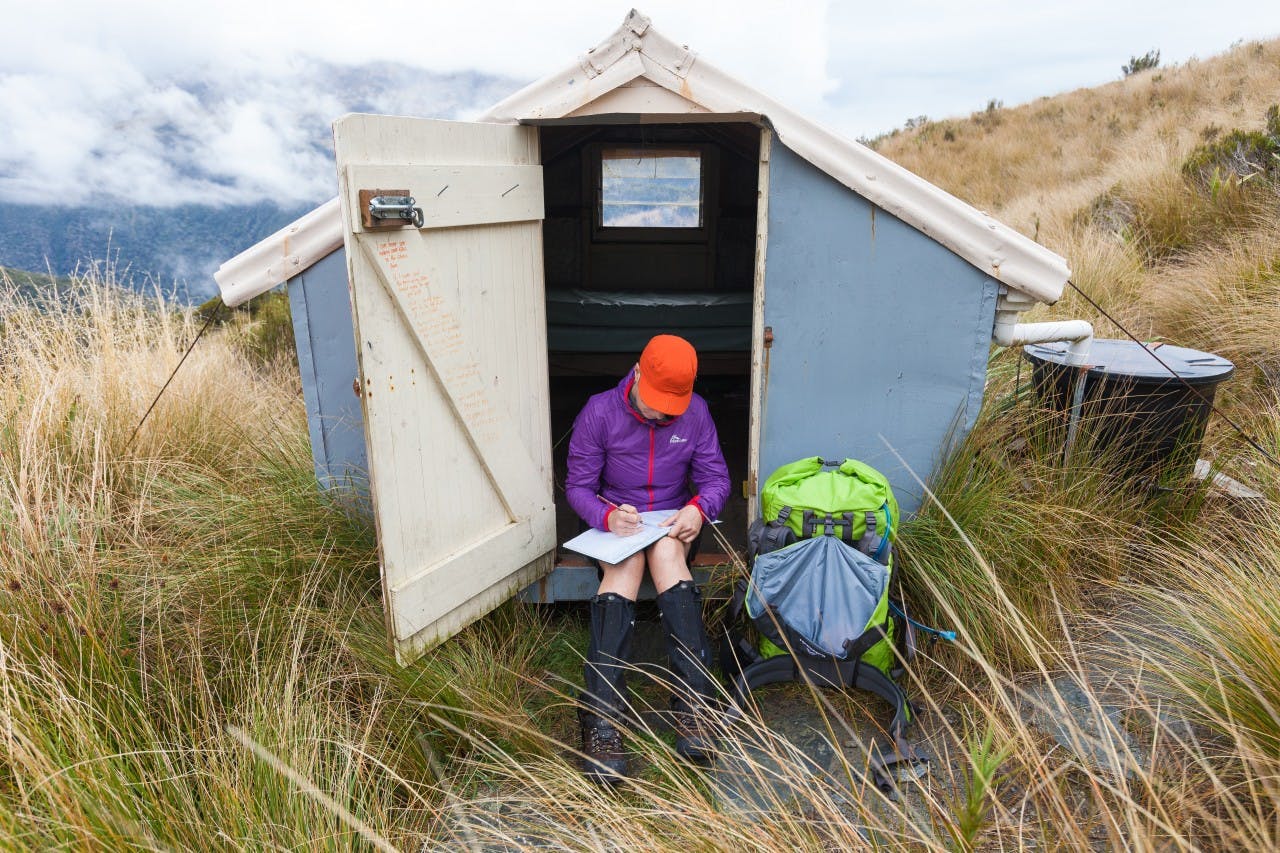
Signing the hut book at Adenture Bivouac – one of 15 huts visited. Photo: Mark Watson
Zit Saddle came slowly after a steep climb out of Top Kokatahi Hut, weaving up the steep riverbed and then ascending tussock slopes. After two days of walking deep in the valleys, the view was entrancing: strands of mist billowed around us, and below and distant lay the coastal plain and the Tasman Sea. The sense of oppressiveness that comes from horizons being limited to untouchable ridgelines lifted, and we each stood, in our own thoughts, gazing at our new view. The range fell away steeply into the Toaroha, its weathered spurs like the ribs of some great starved beast.
We picked our way down towards a cream coloured dot in a clearing far below, seeking the smoothest line down spurs and gullies until we picked up a marker and a ground trail coalesced beneath our wet feet.
Adventure Bivouac: what a perfect morning tea spot. The sun was out and the wind light. I dropped my pack and prised open the door. The mustiness that greeted my nostrils was familiar: damp wood, tin and vinyl mattresses.
A long and steep downhill tramp to the river followed. Just when we were getting used to the breezy tops, a Tolkein-like forest swallowed us. Rata grew in gnarled spirals. The green was deep, lush, heavy. Before long, a light drizzle began. Then it rained steadily. I tightened my cuffs to stop the water seeping in and shrugged deeper into my hood. The muffled rush of the river below slowly grew louder and the descent abruptly ended. Rain spattered the surface of the green water as we waded through, cold water swirling around our legs, filling gaiters and boots.
A rock overhang beside the river bank looked tempting and we squeezed beneath it to shelter from the rain. We cooled, muscles stiffened and slowly we began walking again, towards the upper valley.
Top Toaroha Hut # Day Six
Squally, wind driven rain drummed on the tin roof, waking me. I rolled onto my side, looking towards the water-stained window and wondered what time it was. Thunder rolled overhead, like a hundred jumbo jets and a bright flash of lightning brought momentary daylight to the hut. The other three rustled in their bags, awake too. Dawn was coming to the valley, hidden under dark, fast moving clouds.
We’d planned an early start, excited to cross into another valley and reach Bluff Hut. Slowly the others sat up on their bunks. We discussed our options, but the conclusion was obvious: stay put. After several days on the trot, a lie-in was welcome.
A puddle formed on the floor beneath our wet jackets and packs, and the window louvres rattled in the wind. Outside, the tussock glistened in the wet, thrown to and fro by the wind.
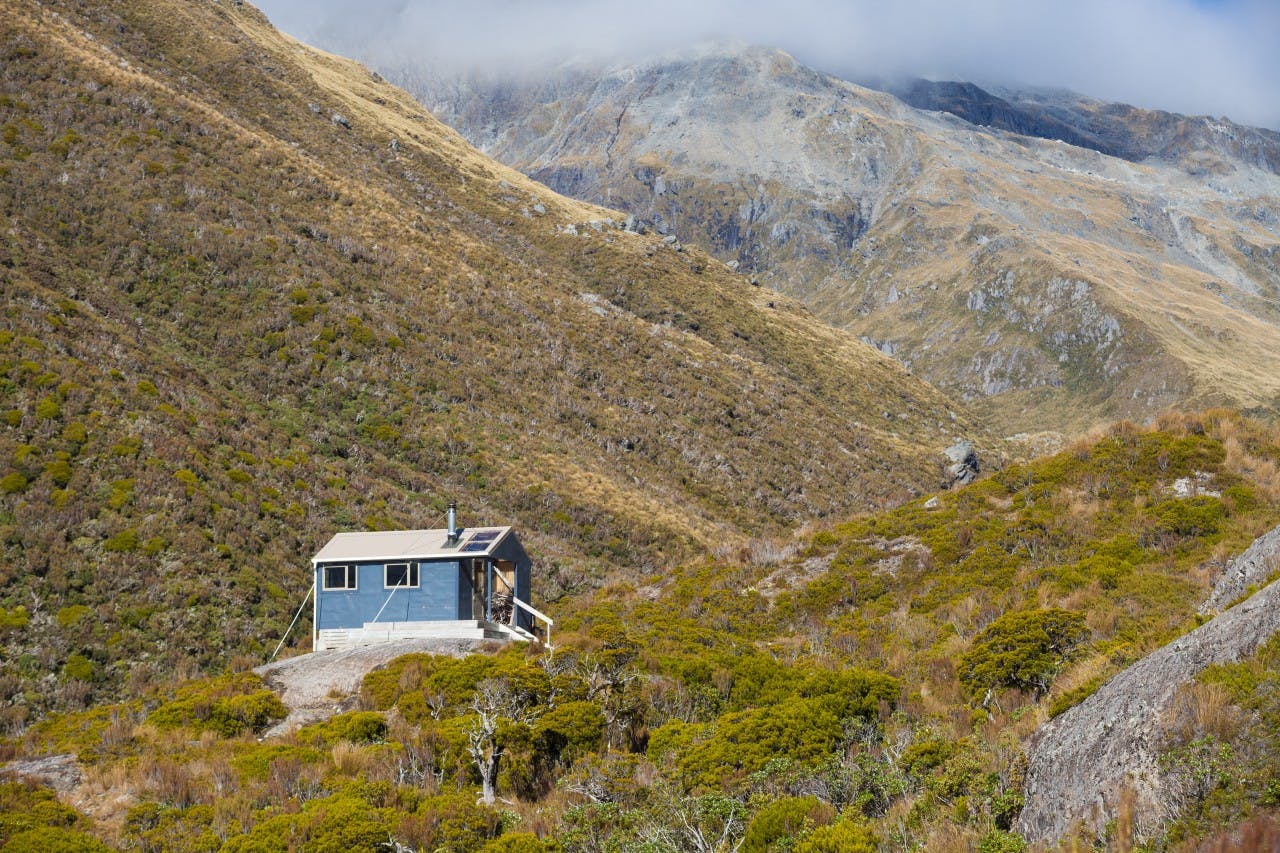
Bluff Hut. Photo: Mark Watson
By mid morning we were feeling settled in, but the wind dropped a little and more light filled the steeply walled valley as the rain thinned. We decided to push on over to Poet Hut; the bivouac on Toaroha Saddle would provide shelter if the weather kicked back in.
Dressed in waterproofs, we walked on, the soggy plants pulling at our legs, hopping small streams and beginning the steep climb to Toaroha Saddle, sometimes hauling on small trees, feet slipping in the wet gravel.
By the time we crossed the pretty stream below the saddle, the drizzle had ceased but a fresh wind coursed over the tops. The final climb to the saddle is a push through sometimes waist-high tussock. We stumbled over hidden holes and rocks, careful to avoid the speargrass.
The saddle biv was a welcome lunch stop, sheltering us from the cold wind. We squeezed in, but left the door open, not wanting to separate ourselves too much from the enticing world outside.
Poet Hut # Day Six
We found our way off the saddle in clear visibility while the Main Divide opposite remained under thick cloud. Skidding down the hill on dracophyllum leaves and mud, the descent went quickly, even on tired knees, and we were met by the roar of the Mungo River, its waters gunmetal with the recent rain. A rooty track led us to a sunless grassy clearing and there stood Poet Hut.
The hut was musty and a little breezy, and rat poo was scattered about. A photocopy of a hut book dating back to the late 1970s accompanies the modern one. The entries are a window into the world of deer culling in these valleys and ranges. A world of animal counts, ammo rationing and being in the bush for weeks at a time. Poetry and stories of day-to-day life colour the world of the hunter and bring another perspective to this classic 1950’s hut. Its four bunks had been home to legions of wilderness travellers over the years.
We set a fire to stave off the night chill and sat in sleeping bags, sharing the book and the FMC bulletins while the hut filled with the odour of crusty socks drying in front of the flames.
Frew Saddle Bivouac # Day Seven
The morning brought the first clear sky of the trip, and we set off early, picking our way downstream over boulders alongside the roaring river, colours rich under a lacquer of dew.
Surrounded by golden tussock, we dropped our packs beside Frew Saddle Bivouac and sat in the sun, happy to rest. Legs, tired from seven days on the go, had carried us back up onto the tops from the deep watercourse of the Hokitika River, up a devious line through schist cliffs and to the relatively new Bluff Hut, sited spectacularly on a rock outcrop on the flank of the Main Divide. An angular topography characterised the landscape and we felt small among the big ridges and vertical terrain.
We walked a vague trail through the broad valley, once home to a large glacier, before turning right and finding our way up the slope to Frew Saddle. We weaved our way through tall tussocks, taking the line of least resistance. I turned often to look out to the valley, tracing our route with my eye and enjoying the calm of a clear day to absorb the environment.
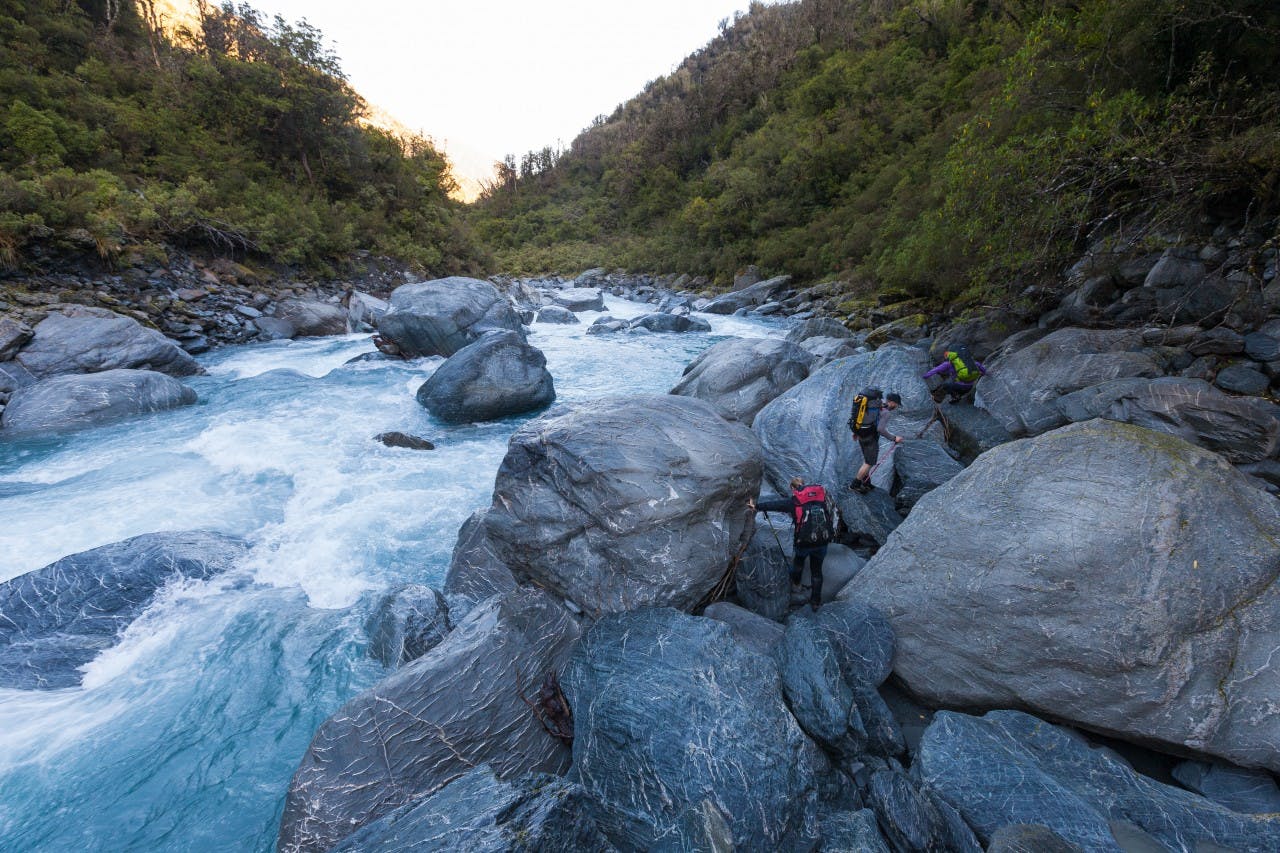
Boulder travel in the Mungo River. Photo: Mark Watson
Frew Saddle was a magical spot to spend our last night in the hills. The bivvy here was built by Jock Fisher and Merv O’Reilly in 1957 and was the first two-person culler’s biv built in the Westland mountains – a template for many more huts and bivouacs to come in the following years.
It was Tom and Anna’s turn to have the bivouac, while Hana and I found a tent site and organised ourselves in an unhurried fashion; enjoying the atmosphere of the location as cloud from the west occasionally spilled over the saddle – swallowing us in mist and obscuring the view – before clearing again to let the sun’s warmth in.
Rapid Creek Hut # Day Eight
The door dragged on the floor as I pushed it open and we walked into the small hut, boots and all. Soaked to the waist from our wade through the hut’s fast-moving namesake creek, we sat down and ate and drank.
Jackets, wet from the rain, slowly steamed in the gloom of late afternoon and I was sticky and damp inside. Clothes dirty and smelly from eight days on the trot. None of us had been in this valley before so we made the stop brief, to lessen the after-dark route-finding hassles that might be coming.
At the lonely cableway that crossed the wide river, water dripped on us as we held the small aluminium carriage steady for Hana to climb into. Then we let gravity take over. The carriage sped over the river, into the drizzle, nearly swallowed by the darkness. Tom took the handle and assumed winding duty as the carriage gradually climbed from the apex of the cable up to the tower on the far side.
The remainder of the walk to the car took longer that it should have. In the dark and rain we occasionally lost the route as it entered stands of regenerating bush and crossed grass flats; track markers were non-existent. A large eel slapping the shallow water gave me a fright as we crossed the last small stream and soon after, the car’s number plate flashed under the light of our torches. Cold, wet and muddy we piled inside and eased down the road – wiper blades slashing the heavily falling rain from the windscreen – and headed to town.
All photos from this trip











